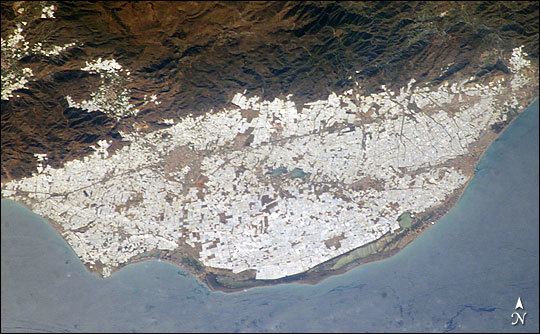 | ||
Man-made structures visible from earth orbit without magnification (by mechanical aids such as a camera or binoculars) include highways, dams, and cities. The most commonly cited example, the Great Wall of China, is barely visible from low Earth orbit, and even then only under perfect conditions, but not from the Moon.
Contents
Part of the problem in authoritatively answering questions about visibility from space is that such questions are often very vaguely framed: askers frequently do not precisely define how far above sea level their hypothetical or actual observer in space is located. When just speaking of "space", an asker might mean anywhere from the edge of space (Kármán line) at an altitude of 100 kilometers (62 mi) to low Earth orbit of 160–2,000 km (99-1200 mi) to Apollo 12's orbit at 290 km (180 mi) to the Moon, which orbits about 381,415 km (237,000 mi) away. The Kármán line is accepted by the World Air Sports Federation, an international standard setting and record-keeping body for aeronautics and astronautics, as the boundary between the Earth's atmosphere and outer space. However, a practical definition for the purpose of answering questions on what astronauts generally can see from space would reflect altitudes that manned spacecraft typically orbit the Earth at—often several hundreds of kilometres. Because of the inverse square law, there are major differences in visibility from just above the Kármán line (100 km/62 miles) and the ISS orbit (394 km/245 miles), for example.
Examples
From US Space Shuttles, which typically orbit at around 135 miles (237 km), cities are easily distinguishable from surrounding countryside. Using binoculars, astronauts could even see roads, airports, dams, harbors, even large vehicles such as ships and planes. Cities are also visible from the higher orbit of the ISS.
Metropolitan areas are clear at night, particularly in industrialized countries, due to a multitude of street lights and other light sources in urban areas (see light pollution).
The Greenhouses of Almería
The greenhouse complex that covers almost 50,000 acres (200 km2) in the province of Almería, Andalucía, Spain is visible from space.
The Great Wall of China
The claim that the Great Wall of China is the only man-made object visible from the moon or outer space has been debunked many times, but remains a common misconception in popular culture. According to astronauts Eugene Cernan and Ed Lu, the Great Wall is visible from the lower part of low Earth orbit, but only under very favorable conditions.
Different claims are made for the factoid that the Great Wall is visible from the Moon. William Stukeley mentioned this claim in his letter dated 1754, and Henry Norman made the same claim in 1895. The issue of "canals" on Mars was prominent in the late 19th century and may have led to the belief that long, thin objects were visible from space. A viewer would need visual acuity 17,000 times better than normal to see the Great Wall from the Moon.
Popular culture
Trivia questions and urban legends often claim certain constructed objects or effects are so large they are visible from outer space. For example, a giant beaver dam in Canada was described as "so large it is visible from outer space." Field and Stream, a Canadian Magazine, wrote, "How big? Big enough to be visible ... from outer space."
